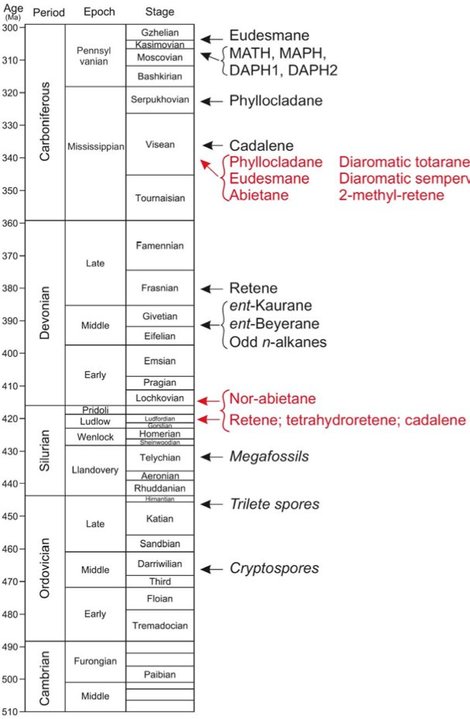Page path:
- Home
- Heisenberg Group: Marine Kerogen - From Biomolecule to Geomolecule
- The Palaeozoic Terrestrialisation
The Palaeozoic Terrestrialisation
The terrestrialisation represents one of the major transitions in the evolution of life and environment. Our working hypothesis is that the major changes in biosynthetic pathways which accompanied the terrestrialization of organisms are reflected in the molecular composition of the organic matter present in Palaeozoic sedimentary rocks and can be used to understand the terrestrialization process.
Project: Molecular and Stable Isotopic Composition of Palaeozoic Plant Fossils
To better understand the evolution of land plants, and their impact on biogeochemical cycles this project investigates the lipid and kerogen chemistry as well as stable isotopic composition of plant-derived organic micro- and macrofossils.
| Cooperation Partners | Armelle Riboulleau, Univ Lille 1, France Thomas Servais, Univ. Lille 1, France Paul Strother, Boston College, USA Marco Vecoli, Univ. Lille 1, France |
| Post. Doc. | Melesio Quijada |
| Programme | ANR - TERRES |
| Funded by | CNRS France |
Finished project: Biomarkers of Palaeozoic Land Plants
| Cooperation Partners | Armelle Riboulleau, Univ Lille 1 Marco Vecoli, Univ. Lille 1 |
| PhD Student | Maria Fernanda Romero Sarmiento |
| Programme | ECLIPSE II |
| Funded by | CNRS France |
Abstract: The aliphatic and aromatic biomarker content from terrestrial and marine sediments of Late Ordovician to Early Carboniferous age have been related to their palynomorph assemblages (e.g. acritarchs, prasinophytes, chitinozoans, cryptospores, trilete spores and megaspores) in order to contribute to the knowledge of land plant evolution during the Palaeozoic. This investigation is therefore focused on the land-derived biomarkers and their attributions to specific kind of plants. The biomarker record of middle Silurian – lower Devonian sediments from southern Tunisia, Ghadamis Basin (Gondwana) reveals the presence of retene, cadalene, kaurane, norabietane, tetrahydroretene, C19 isohexylalkylnaphthalene and simonellite. The early Palaeozoic bryophytes and tracheophytes (e.g. Cooksonia, lycophytes and zosterophylls) may therefore be considered as potential precursors for retene and its related molecular compounds in sediments of Middle Silurian to Early Devonian age. In contrast, the Early Carboniferous flora formed by arborescent lycopods, sphenopsids and pteridosperms have been suggested here as a possible terrestrial source for phyllocladane, abietane, ent-beyerane, bisnorsimonellite, diaromatic totarane, diaromatic sempervirane and 2-methylretene in the Lower Carboniferous (Viséan) coal deposits at Dunbar (East Lothian, Scotland). Among the other biomarkers detected in our samples, ionene, alkyldibenzofurans, perylene and combustion-derived polycyclic aromatic hydrocarbons (PAHs) indicate pollen, lichens, fungi and vegetation fire contributions, respectively. Most of the biomarkers identified here had been so far generally associated to conifers, though conifers only evolved during Late carboniferous. These compounds therefore are also characteristic of early land plants.

Earlier first occurrences of terrestrial biomarkers (in red) obtained during this project (From: Thesis Maria Fernanda)


